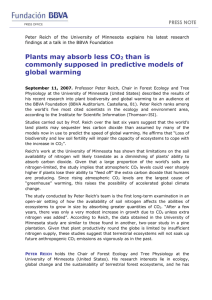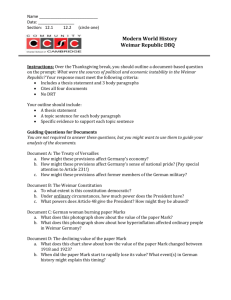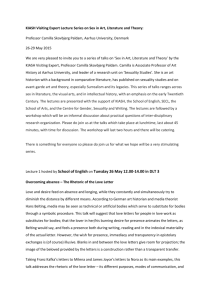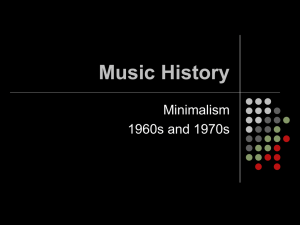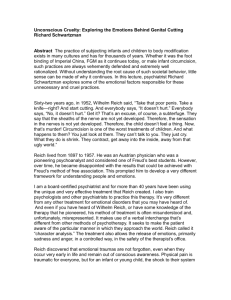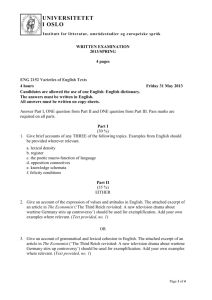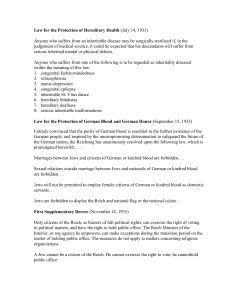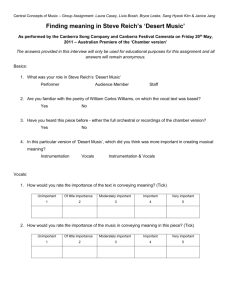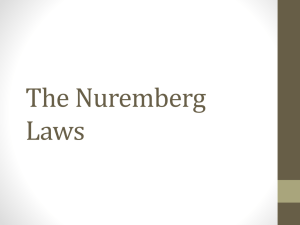Wilhelm Reich and UFOs
advertisement
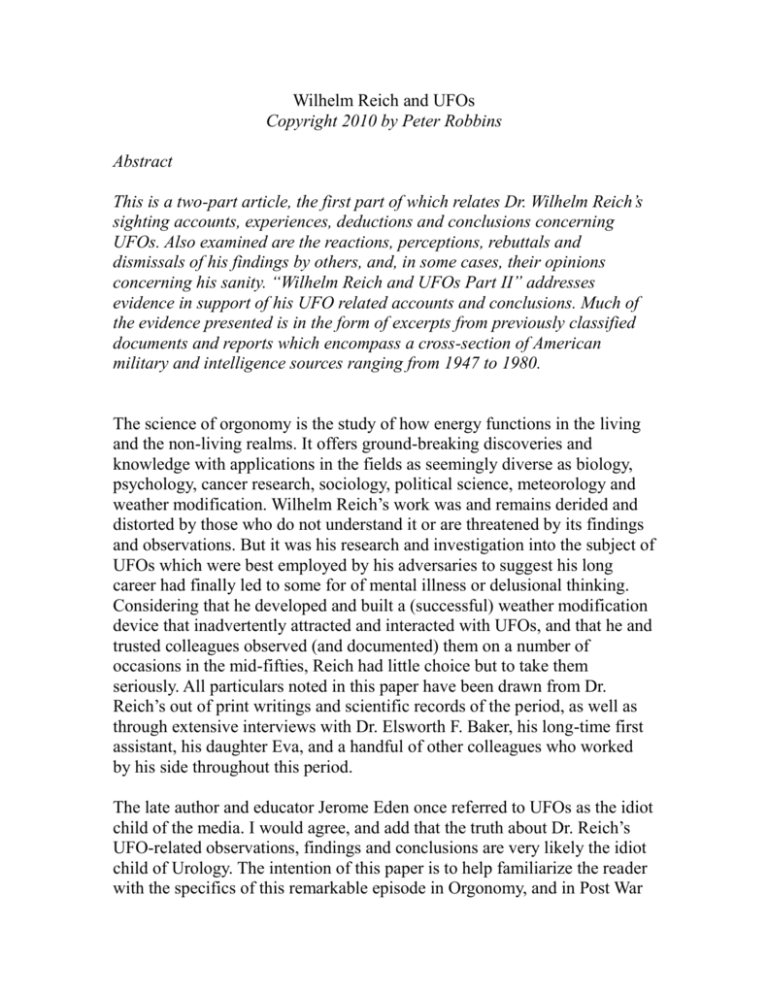
Wilhelm Reich and UFOs
Copyright 2010 by Peter Robbins
Abstract
This is a two-part article, the first part of which relates Dr. Wilhelm Reich’s
sighting accounts, experiences, deductions and conclusions concerning
UFOs. Also examined are the reactions, perceptions, rebuttals and
dismissals of his findings by others, and, in some cases, their opinions
concerning his sanity. “Wilhelm Reich and UFOs Part II” addresses
evidence in support of his UFO related accounts and conclusions. Much of
the evidence presented is in the form of excerpts from previously classified
documents and reports which encompass a cross-section of American
military and intelligence sources ranging from 1947 to 1980.
The science of orgonomy is the study of how energy functions in the living
and the non-living realms. It offers ground-breaking discoveries and
knowledge with applications in the fields as seemingly diverse as biology,
psychology, cancer research, sociology, political science, meteorology and
weather modification. Wilhelm Reich’s work was and remains derided and
distorted by those who do not understand it or are threatened by its findings
and observations. But it was his research and investigation into the subject of
UFOs which were best employed by his adversaries to suggest his long
career had finally led to some for of mental illness or delusional thinking.
Considering that he developed and built a (successful) weather modification
device that inadvertently attracted and interacted with UFOs, and that he and
trusted colleagues observed (and documented) them on a number of
occasions in the mid-fifties, Reich had little choice but to take them
seriously. All particulars noted in this paper have been drawn from Dr.
Reich’s out of print writings and scientific records of the period, as well as
through extensive interviews with Dr. Elsworth F. Baker, his long-time first
assistant, his daughter Eva, and a handful of other colleagues who worked
by his side throughout this period.
The late author and educator Jerome Eden once referred to UFOs as the idiot
child of the media. I would agree, and add that the truth about Dr. Reich’s
UFO-related observations, findings and conclusions are very likely the idiot
child of Urology. The intention of this paper is to help familiarize the reader
with the specifics of this remarkable episode in Orgonomy, and in Post War
history.
Science is best served by accepting or rejecting an idea on the basis of its
efficiency, not its appearance, history, origin, number of supporters or its
supporters’ credentials. Max Planck, a winner of the Nobel Prize in Physics,
arrived at the following conclusion on the basis of his own observations:
… as a rule, new scientific truth is not accepted by its opponents
acknowledging recognition and declaring themselves convinced. Instead, it
wins out because its adversaries pass away and the new generation has been
from the start acquainted with the truth (3:ii)
In the matter of serious inquiry into the question of UFO and their
implications, we have an exception; by and large, each new generation of
establishment scientists remains as unwilling as unwilling to take the matter
any more seriously than those who preceded them.
Why was Wilhelm Reich interested in UFOs, and how did he arrive at his
conclusions concerning them?
Reich’s interest in UFOs dates from 1953 (4:6). Until then, there is no
indication that he had paid any attention to all the publicity surrounding
“flying saucers,” even when, in 1952, some visitors to his home and
laboratory in Rangeley, Maine (now the Wilhelm Reich Museum – see
Phenomena, 09/10/04, page 14) reported seeing shining objects in the sky
that were decidedly not stars. In November 1953, though, he read one of the
best books available on the subject at the time, Flying Saucers from Outer
Space (4:7). The author, a retired Marine Corps Major named Donald
Keyhoe, was a highly respected and decorated fighter pilot and pioneered
much of the basis for modern scientific UFO studies in America. Reich’s
writings indicate he was intrigued by Keyhoe’s observations that their
silence, maneuverability and speed repeatedly defied conventional laws of
mechanical flight. At the time, Reich wrote:
I had not studied anything on the subject: I knew practically nothing about it.
But my mind, used to expecting surprises in natural research, was open to
anything that seemed real. (4:5)
He also read E. J. Ruppelt’s Report on UFOs. This book, by a retired USAF
Captain who had headed the Air Force’s ongoing UFO record-keeping (and
public relations) program, Project Blue Book, prompted Reich to note:
The Ruppelt Report on UFOs clearly reveals the helplessness of mechanistic
method in coming to grips with the problems posed by the spacemen. The
cosmic Forgone energy which these living beings are using in their
technology is beyond the grasp of mechanistic science since cosmic laws of
functioning are not mechanical but what I term “functional.” The
helplessness of mechanical thinking appears in the tragic shortcoming of our
fastest fighter jets to make and hold contact with UFOs. Being unavoidably
outdistanced is not a flattering situation for military pride. The conclusion
seems correct: Mechanistic methods of locomotion must be counted out in
coping with the spaceship problem.
One night as he sat on the steps outside his home in Maine, something
flashed by at great speed, its behavior not suggestive of a comet, meteorite,
or shooting star. Reich reported the sighting to the Air Force Base at Presque
Island, Maine; it was the first of many sighting reports he forwarded to the
Air Force (4:94). He was then asked to fill out an official questionnaire. In
March, 1954, Reich sent a copy of his survey on UFOs to the Air Force. The
survey was actually a manuscript detailing his theoretical conclusions of
them as spacecraft.
Basic to Dr. Reich’s understanding of the universe was the pervasive
presence of energy (which he termed Forgone energy), implying the
possibility of life in space. At this time his questioning encompassed the
galactic currents, the formation and destruction of star systems, and the
origin of the universe itself. Along with his deepening involvement in
cloudbusting, he now began a careful examination of the stars and set about
proving that some ‘stars’ did not behave like others. The method was
nocturnal, time-lapse photography. The camera was carefully set and the
experiment proceeded with unexpected results. Some of the stars did not
produce the white lines caused by the Earth’s rotation. These stars simply
vanished. They were something else. He now began to wonder in earnest
what they were, and specifically what they were doing in the skies over
Maine.
Reich saw the Oranur Experiment, with its massive pollution of the Maine
area, as the cause of their immediate interest in the region. Considering his
own observations, those of a number of co-workers, and independent reports
of UFO activity over Maine, it was hardly egoistic that he should assume
that his activities might be the subject of their special attention (4:31).
It is widely held by many students of UFO studies (and in a number of early
classified military and intelligence reports as well) that the early detonations
of our atomic bombs were a possible trigger for these visitations, or revisitations.
In February 1949, the Air Force issued its first known extensive intelligence
report on UFOs, Project Sign. The paper, which was classified SECRET,
was declassified in the late 1970s. In regard to the possibility of some UFOs
being someone else’s spaceships, it states somewhat prophetically:
A. If there is an extraterrestrial civilization which can make such objects as
are reported then it is most probable that its development is far in advance of
ours. This argument can be supported on probability arguments alone
without recourse to astronomical hypotheses.
b. Such a civilization might observe that on Earth we now have atomic
bombs and are fast developing rockets. In view of the past history of
mankind, they should be alarmed. We should, therefore, expect at this time
above all to behold such visitations.
If these craft had harnessed the sea of energy pervading the universe, what
might be the effect of training a cloudbuster on one? … The results of this
action were both profound and disturbing. He writes:
I hesitated for weeks to turn my cloudbuster pipes toward a “star” as if I had
known that some of the blinking lights hanging in the sky were no planets or
stars but space machines. With the fading out of the two “stars,” the
cloudbuster had suddenly changed into a space-gun … When I saw the
“star” to the west fade out four times in succession, what had been left of the
old world of human knowledge after the discovery of Forgone energy,
tumbled beyond retrieve. From now on everything, anything, was possible
Nothing could any longer be considered “impossible.” I had directed the
draw-pipes connected with the deep well towards and ordinary star and the
star had faded out four times. There was no mistake about it. Three more
people had seen it. There was only one conclusion: The thing we had drawn
from was not a star. It was something else – a UFO … The shock of this
experience was great enough not to repeat such an action until 10 October
1954 (4:4-5)
Preceding this, on October 5 and 6, three large, yellow UFOs hung low over
the southern horizon and another over the observatory on Reich’s property.
On the 10th, a large reddish UFO hovered just to the south of the property. At
this point, the cloudbuster was trained on it and it moved. Followed by the
cloudbuster, it became less red, moved higher, and later sank down below
the horizon. Shortly thereafter, a second one (yellow) appeared in the west.
After two minutes of direct drawing, it faded, came back, flashed, pulsated,
and wobbled while moving irregularly from south to north. There was for
Reich the distinct, subjective impression of a struggle. It came back again
shortly after, and again, became fainter and smaller after drawing on it. At
this point there were at this four in total (to the north, south and west) which
then removed themselves, disappearing from sight (4:34).
On October 10, for a second time, Reich dimmed “stars” and induced them
to move, “as if in flight in different directions.” He again concluded they
were machines, and not ones of terrestrial origin.
Reich’s point of view on UFOs shifted between 1953 and 1957. At first he
theorized they were benign observers, but gradually became convinced that,
either by intention or accident, they were contributing to the pollution
accumulating in the atmosphere.
Contact With Space, privately published after Wilhelm Reich’s death in
1957, documents early weather modification, or CORE (cosmic Forgone
engineering) operations and the 1954-55 cloudbusting expedition to Arizona.
The book, published in an edition of only five hundred, details a great deal
more information than this paper is designed to cover, and it is not my
intention here to synopsize this sweeping text, only that Reich’s scientific
observations of, interactions with, and findings on UFOs chronicled in
Contact With Space made it indispensable in the preparation of this article.
The following day, October 11, Reich authorized his friend, research
associate and son-in-law (who was a trained cloudbuster operator), to call
the Air Technical Intelligence Command (ATIC) in Dayton, Ohio, and make
an appointment to discuss the disabling of the UFOs the previous day. Moise
was in Ohio on his way to Arizona at the time. A meeting with a General
Watson was agreed upon on for October 14. Over the phone Watson asked
Moise, if necessary, could their conference be continued into the evening,
and how did Reich know that the UFOs had been disabled? Moise arrived at
the facility early on the 14th where he was met by a Dr. Byers, a physicist
employed by the command. Byers escorted Moise to the conference, also
attended by a USAF Captain Hill and a civilian named Harry Haberer (6:8).
Asking where General Watson was, Moise was told that he was unable to
attend. Angered, Moise left and returned to his Dayton motel. The next day
Moise received a phone call from Captain Hill conveying Watson’s
apologies and was asked if the report could be made to ATIC Deputy
Commander Colonel Wertenbaker. Moise agreed and they met later that day.
Present were Captain Hill, Dr. Byers, Haberer and the Colonel. Moise gave
an oral presentation and all took notes except the Colonel. Feeling that this
had been a significant meeting, that at least some breakthrough had been
made in interesting a branch of the government in Reich’s observations of
the involvement with UFOs, Moise wrote that:
The contact with Col. Wertenbaker was excellent throughout the conference.
He was serious, intent and looked at me while I talked. He was the only one
who did. His excitement increased as the report progressed. (4:86)
Several days later, the Colonel wrote to the Director of Intelligence for the
Air Force – somehow this note ended up in the Food and Drug
Administration’s case file on Reich. It read in part:
General Watson did not talk personally to Mr. Moise, I am happy to say, but
I interviewed this person . . . the information given us by Moise defies
description and I’ll not attempt to give you the details . . . the Air Force will
do well to avoid entanglements but what is absolutely necessary from the
standpoint of good public relations
Dr. Byers, the physicist, told Moise that he was familiar with Reich’s work.
Harry Haberer, the civilian in attendance, was described as working on the
history of UFOs with the Air Force. Leaving Ohio, Moise continued on to
Arizona. Meanwhile, Reich, his son Peter, and several others were driving
west as well. Traveling cross-country to Arizona, in author David Boadella’s
words:
Reich’s account of the 3200-mile journey (4:111-131) is a masterpiece of
reportage on subtle nuances that he noticed in the atmosphere, in vegetation,
and in the soil on the journey. To read it is to learn how much we all walk
about with our eyes shut and how insensitive we tend to be towards the
emotional feel of the environment. (7:299)
They carried an appropriate assortment of laboratory equipment (4:134-136),
each vehicle with a cloudbuster in tow. They arrived at the leased property
ten miles outside of Tucson on October 19, 1954. Settled in, they
commenced drawing operations, regularly observing the atmosphere with
their meteorological instruments. Records were kept in accordance with
strict scientific method. Individual journals were also kept.
Robert McCulloch, another trained cloudbuster operator, assisted Reich and
Moise in the operation. Drawing began at the end of October and many
UFOs were observed during the nights of October 31 and November 1 over
the area. By November 7, moisture in the atmosphere had risen from the
usual 15% to 65%, an unheard of relative humidity for Tucson. Drawing
continued, mostly from the southwest direction. On November 7, the first
clouds were forming thickly and soon covered the sky, indicating rain. Then,
without apparent explanation, the clouds began to decompose. That evening,
a large, bright UFO was seen coming up from the north. It moved slowly
southwest until it stopped and hovered for several hours ten to fifteen
degrees above the southern horizon. A connection between the dissipation of
clouds and the presence of UFOs in the skies seemed unavoidable after this
sequence of events continued to repeat itself. (4:136-164)
By November 13, the relative humidity had risen to 67% and rain seemed
imminent in a location which had seen none in five years. But by that
evening the humidity had dropped twenty points to 47%. The next day, two
bright, pulsating, flashing UFOs were seen low in the eastern sky. Upon
direct draw, the first dimmed after an initial stronger blinking, then remained
dim. The second wobbled, then it too, dimmed markedly. Suddenly, a third
came up in the east, as if from nowhere. Early on the morning of the 18th, a
UFO was seen on the horizon and within two hours an Air Force aircraft was
seen circling the area. More UFOs continued to be observed in direct
relationship with the destruction of the relative humidity. (4:168-172)
On the morning of November 29th, Reich, looking at the eastern sky through
a three-and-a-half inch refracting telescope, observed a fully articulated
cigar-shaped craft. In his notes he writes that he first refused to accept the
notions, but windows were clearly observed on the object and recorded in
his drawings. The ship was observed, as cloud cover would allow, off and on
between December 1 and December 17. Charts of its movements were kept.
(4:175-178)
By December 14, the atmosphere in the area of the base camp, and indeed,
in Tucson itself was oppressive and deadening. Just prior to this Reich’s
associate, Dr. Silvert, had transported a small amount of radioactive material
that had been exposed in an accumulator from Maine to the Tucson site. The
material had to be towed on a cable one hundred feet behind a hired plane as
its lead shielding was unable to contain its altered reaction. At about 4:30
PM, a huge black cloud formed over the Tucson area, gradually turning deep
purple with a somewhat reddish glow. The background radiation count in the
area jumped to an alarming one hundred thousand counts per minute. The
usual background count had been holding at six to eight hundred counts per
minute. Twelve Air Force planes overflew the base camp and their contrails
(made of water vapor) quickly dissolved. Twenty minutes after both
cloudbusters began drawing, the skies cleared At 5:30 PM four B-56
bombers flew in low over the area. Reich felt that this “cloud” masked the
presence of other UFOs. If so, this incident was indeed properly categorized
as a battle. Interest in the newly arrived and highly aggravated radioactive
material was a suspected cause of their appearance. (4:199-201)
In Contact With Space, Dr. Wilhelm Reich’s reflections on the possible
implications of an extraterrestrial reality are often moving, profound and
disturbing. Reich dares, as a scientist, to exercise a most precious right: the
right to challenge an established and accepted belief, the right to think a
thought, no matter how others might perceive it, recording that thought for
publication and standing by it in the face of almost universal criticism. Read
out of context – that is, without benefit of any serious study of his thirty five
years of previous writings, methodology or discoveries – even the most
intelligent and perceptive reader might find it preferable to dismiss his
observations as bearing witness to a great mind finally derailed, rather than
to contemplate them seriously.
Since his death, most accounts of Reich’s life and work, be they supportive
or otherwise, follow a similar logic: that the level of importance which he
ascribed to his UFO observations is, in itself, a means of “proving,” or at
least suggesting that Reich had gone quite mad during his last years. Such
material is often presented in a manner suggesting that a good deal of
“fairness,” objectivity and patience were spent in ‘sorting all this out’ for the
reader. Others don’t even bother. With no serious grounding in either UFO
studies or orgonomy and no real interest in fair scientific inquiry or method,
they accuse and rant, exposing the madness they perceive. Often written in
angry displays of public-spirited concern, they warn the good reader away,
like police at the scene of an accident. Other accounts are simply inaccurate.
James Wyckoff, in Wilhelm Reich – Life Force Explorer, tells us that:
At the same time {as Reich was understanding weather control}, he became
interested in UFOs – unidentified flying objects. It is during this period
especially that people assert he “really did go crazy.” Certainly from what
one reads (not always a reliable source of truth) he did become a “paranoic,”
feeling that the communists, the “Red Fascists,” were after his discoveries,
and even later that the earth was being attacked by spacemen. (8:119)
For those who prefer pictures, Reich for Beginners, a comic book written by
David Zane Mairowitz, gives us the author’s version in lively present tense:
Reich now becomes convinced that UFOs (or Ea’s as he calls them) are
fueled by Forgone and that DOR {deadly orgone energy} is the exhaust of
these machines. The Earth is under attack from outer space and space ships
have landed at Orgonon.1 If he can find a way to use the cloudbuster as a
space gun, he can make contact with them. (9:160)
(Footnote to be located at bottom of appropriate page) 1 A claim which, to
the very best of my knowledge, neither Reich, nor any of those around him,
nor anyone else, for that matter, has ever made.
David Boadella, author of the 1973 work, Wilhelm Reich: The Evolution of
His Work, observes that:
In the popular mind, merely to entertain the idea of such objects seems, in
itself, to be at the least cranky, if not positively delusionary , or the product
of a deliberate hoax. (7:299)
Boadella is “fair.” He grants that:
…at no time in his life did Reich ever suffer from any form of hallucination
or observational carelessness. Since the form gave no scope for
observational constructs, Reich was tied down to earth and confined to
observations that were in themselves of the same type that had been made by
thousands of other reliable observers around that period. It is likely that
Reich made such observations on more than one occasion. (7:301)
Then, quoting from Contact With Space, Boadella goes on to say:
On 10 October 1954, for the second time, Reich claims to have dimmed
“stars” and induced them to move “as if in flight in different directions,” He
concludes that “They were space machines. There was no doubt whatsoever
after this second experience that our cosmic energy research was on the right
track. It was standing up to the most exacting techniques of control and
testing.”
This kind of breakdown in reasoning indicates that something in Reich’s
mind had “tumbled beyond retrieve.” (7:303-304)
Colin Wilson, author of The Quest For Wilhelm Reich, is not that kind. This
passage is fairly representative:
The [Reich’s] books seemed to reflect increasing delusions of grandeur. His
“scientific” discoveries became even more preposterous – the orgone
accumulator, the cloudbuster, even a motor that was supposed to work off
orgone energy. Many Reichians claim to have seen the motor operating . . .
and then, in what seemed like an irrevocable step into sheer insanity, Reich
suddenly decided that the human race, and himself in particular, were being
observed by beings from outer space in flying saucers. (10:215)
But Wilson is also “fair”:
Before dismissing Reich’s talk of UFOs as a kind of Don Quixote fantasy,
we should bear in mind that everyone else at Orgonon and Little Orgonon
(the name given to the leased acreage outside Tucson for CORE operations)
witnessed the phenomenon of the “lights” blinking out when Reich pointed
the cloudbuster at them – Peter Reich, for example, describes witnessing it
in his Book of Dreams. Reich may have been suffering from paranoid
delusions by this time – but his impressions were not entirely subjective.
(10:224)
Apparently, claiming to have observed UFOs, and, over time, their behavior,
interacting with them via the cloudbuster, ascribed to them intelligence and
intention, keeping the Air Force and the office of the President appraised of
his activities, and finally, the posthumous publishing of Contact With Space,
proved intolerable to all by a few.
Even A. S. Neil, the distinguished British educator who was Reich’s loyal
friend and colleague of many years, seemed convinced these findings would
only prove to be an embarrassment to orgonomy. But not at first. In March
of 1955, he wrote to Reich:
Thanks for the saucer book which came a few days ago. It sure made me sit
up. So much Air Force testimony can’t be ignored . . . Inclined to accept
your opinion that they are benign, the only problem I can imagine would be
their arrival here to stop the inevitable atomic destruction of all life. Mutual
fear won’t stop war. Almost looks as if Freud was right in saying there is a
death instinct when one sees the whole mass of people thinking of football
and radio etc. at a time when the sinking of a U.S. aircraft carrier off
Formosa or the enthusiasm of a U.S. pilot might set the light to the
gunpowder barrel. Hence I say: let the spacemen come; they might save us
and they came as destroyers they could not be more dangerous than man
himself. (11:392)
I must stress here that Reich had few friendships or professional
relationships of such duration and depth and it is not my intention to put a
particular cast on Neil here. It is just that he articulated the prevailing
attitude so well. In December 1957, a month after Reich’s death, he wrote
this to Ilse Ollendorff, Reich’s former wife and co-worker:
The difficulty will not be to separate what’s valuable from what isn’t. The
idea that the trial was orchestrated from Moscow is just bunkum, and we
have no proof of flying saucers anyway. Why should Reich’s great work be
mixed up with either factor? That Reich later had some illusions I think
right, but they don’t so anything to lessen his work. We all have illusions and
maybe the greater we are, the greater the illusions. But that Eva {Reich’s
daughter} and Moise {his son-in-law} and Steig {cartoonist and illustrator
of Reich’s book Listen Little Man!, and a financial backer of the Arizona
expedition} should go on having illusions is bad, bad for the future of
Reich’s acceptance as a scientist. (12:108)
And there’s the rub: “bad for the future of Reich’s acceptance as a scientist”
– a consideration not taken lightly by Neil and others deeply concerned
about the future of orgonomy. I can only wonder how Neil might have
reacted when students and faculty members at his beloved Summerhill
described to me the UFO sightings they had from the Summerhill property
in Leiston, Suffolk on the occasions I was a speaker there. David Boadella
sums the conundrum up:
…why did the orthodox scientists and psychologists condemn Reich? Why
did they dismiss him as a paranoic while Raknes (a Norwegian colleague)
and Dr. Hoppe of Isreal and lots of the sane American surgeons and
physicians and I thought him to be the most important thinker of our time? . .
. I must face the question that was so often raised by his enemies – his
sanity. . . . Apparently he believed that flying saucers were from other worlds
without due proof. Yet when the judge ordered him to be examined by a
board of psychiatrists, they pronounced him sane. (7:379)
They were not alone. Professor Paul Matthews of New York University
observed in his 1973 review of Boadella’s book:
Reich’s scientific integrity, creativity, and genius, even to the end of his life,
need no defense or confirmation from me; nor does his sanity need defense
in the opinion of those who were closest to him and in a position to gauge
his mental status, character structure, and work capacity at that time. (13)
But does all this really come down to a question of Wilhelm Reich’s sanity?
Medical researcher Ludwik Flek notes in his 1979 book, The Genesis and
Development of a Scientific Fact:
What we are faced with here is not so much a simple passivity or mistrust of
new ideas as an active approach which can be divided into several stages.
(1) A contradiction to the system appears unthinkable
(2) What does not fit into the system remains unseen
(3) Alternatively, if it is noticed, either it is kept secret, or
(4) Laborious efforts are made to explain an exception in terms that do not
contradict the system
(5) Despite the legitimate claims of contradictory views, one tends to see,
describe, or even illustrate those circumstances which corroborate current
views and thereby give them substance. (14:83)
Thus the unacceptable or unacceptable theory is excluded. The individual
who persists in putting forth such a theory may ultimately be excluded and,
in a number of historic incidences, declared to be out of touch with “reality”
or insane. You may have the knowledge of a master scientist and still not be
able to analyze or even see beyond the accepted theories of your own era.
There are things in life which many of us would rather not know of;
questions we may not want answered. Reich asks such a question on page
one of Contact With Space. Much as we – those of us who hold his work and
discoveries in high regard – may wish it didn’t, the passage reads:
On May 20, 1956 PM, a thought of a very remote possibility entered my
mind, which, I fear, will never leave me again: Am I a Spaceman? Do I
belong to a new race on earth, bred by men from outer space, in embraces
with earthly women? Are my children offspring of the first interplanetary
race? Has the melting-pot of interplanetary society already been created on
our planet, as the melting pot of all earth nations was established in the
U.S.A. 190 years ago? Or does this thought relate to things to come in the
future? I request my right and privilege to have such thoughts and to ask
such questions without being threatened to be jailed by any administrative
agency of society. (4:1)
As clearly stated at the outset, this “a thought of a very remote possibility”
{emphasis added}. Reich does not seem to delude himself as to how such a
passage would likely be met by scientist and laymen alike. Despite this, he
chose to put himself squarely in the eye of the storm. Was it, then, because
he believed it to be true? And if so, can this only mean that he had, in fact,
“gone crazy,” or, at the least, suffered from delusions? Or was he simply
exercising his “right and privilege to have such thoughts?” Three pages later
he observes that:
In the face of a rigid, self-appointed, ready-to-kill hierarchy of scientific
censorship, it appears foolish to publish such thoughts. Anyone malignant
enough could do anything with them. Still, the right to be wrong has to be
maintained. We should not fear to enter a forest because there are wildcats
around in the trees. We should not yield our right to well controlled
speculation . . . In entering the cosmic age, we should certainly insist to ask
new, even silly questions without being molested. (4:178-179)
REFERENCES
1. Fort, C.: The Complete Books of Charles Fort. New York: Dover
Publishing, Inc., 1974
2. Goran, M.: The Modern Myth. Cranbury, NJ: A.S. Barnes and Co., 1978
3. Strickland, J.: Superworlds. New York: Grosset & Dunlap, 1975
4. Reich, W.: Contact With Space. Rangeley, Maine: Orgone Institute Press,
1957
5. Truettner, L.H., Deyarmond, A.B., Technical Report on Project Sign
(Classified Secret). Wright-Patterson AFB, Dayton, Ohio: Air Materiel
Command Intelligence Department, February, 1949.
6. Eden, J.: Eden Bulletin, 7(3), Careywood, Idaho, July 1980
7. Boadella, D.: Wilhelm Reich: The Evolution of His Work. London: Vision
Press, 1973.
8. Wyckoff, J.: Wilhelm Reich – Life Force Explorer. Greenwich, CT:
Fawcett, 1973
9. Mairowitz, D.Z.: Reich for Beginners. London: University Press, 1986.
10. Wilson, C.: The Quest for Wilhelm Reich. Garden City, NY, Anchor
Press, 1981
11. Croall, J. (ed.): Record of a Friendship: The Correspondence Between
Wilhelm Reich and A.S. Neill. New York: Farrar &Giroux, 1981
12. Croall, J. (ed.): All the Best, Neill. London, Watts, 1984
13. Matthews, P.: “Book Review,” Journal of Orgonomy, 7(2), November,
1973
14. Westrum, R.: “The Blind Eye of Science,” The Whole Earth Review, No.
52. Fall, 1986
